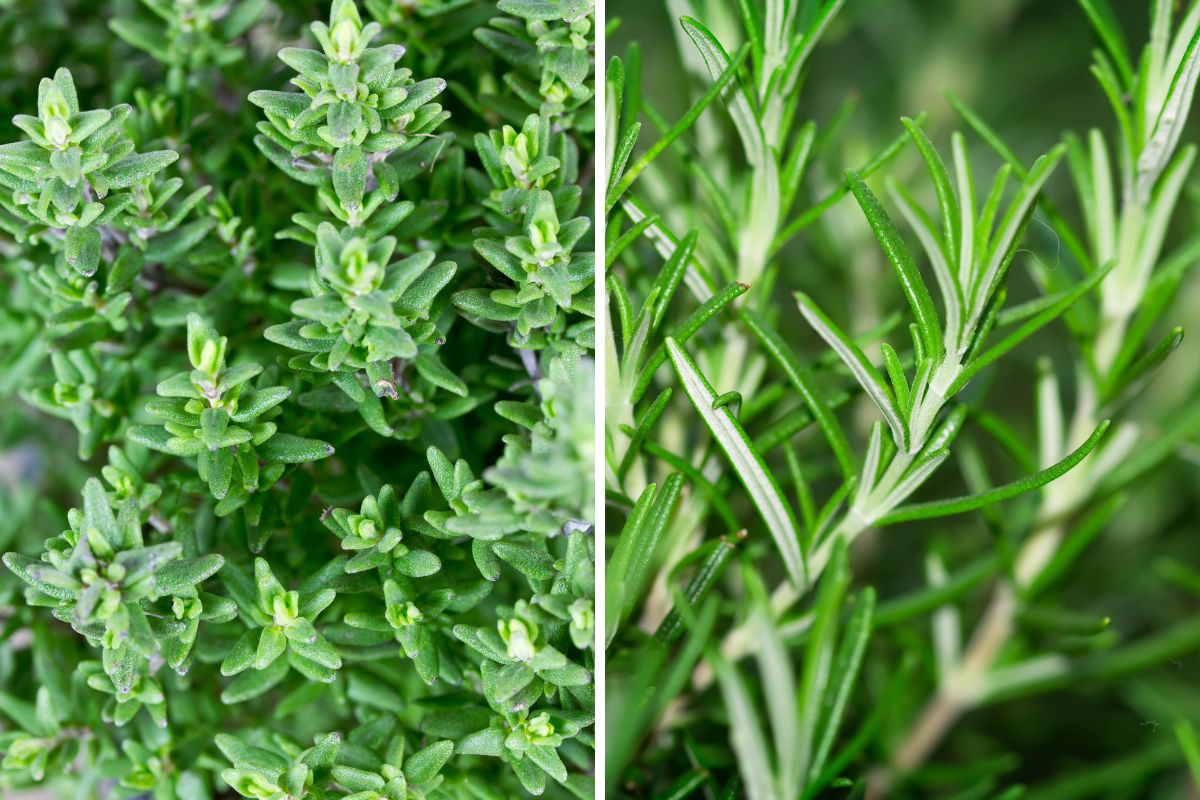Thyme has a subtle, earthy flavor with a hint of mint and lemon that goes well in soups, stews, and meat dishes. Rosemary has a more robust, pine-like flavor with hints of pepper and floral notes, and it is ideal for roasted meats and vegetables, as its bold flavor can stand up to the intensity of high-heat cooking.
Table of Contents
What is thyme?

Thyme (Thymus vulgaris) is an aromatic herb from the mint family. It is a small, evergreen shrub with tiny leaves commonly used as a seasoning in cooking. It can also be a part of other spice blends like bouquet garni.
Thyme has a slightly minty and earthy flavor with a subtle sweetness and a hint of lemon. It is often used to add depth and complexity to savory dishes, particularly in Mediterranean cuisine.
You could describe the flavor of thyme as a milder version of oregano, with a hint of mint and lemon.
What is Rosemary?

Rosemary (Salvia rosmarinus, formerly Rosmarinus officinalis) is also an aromatic herb that belongs to the mint family. It is an evergreen shrub with needle-like leaves. Rosemary has a strong, woody flavor with a slightly bitter, resinous taste. It adds a savory, pine-like flavor to roasted meats and vegetables.
Essentially, rosemary’s flavor combines pine and eucalyptus with a hint of mint and a slightly bitter aftertaste, similar to juniper berries.
What are the differences between thyme and rosemary?
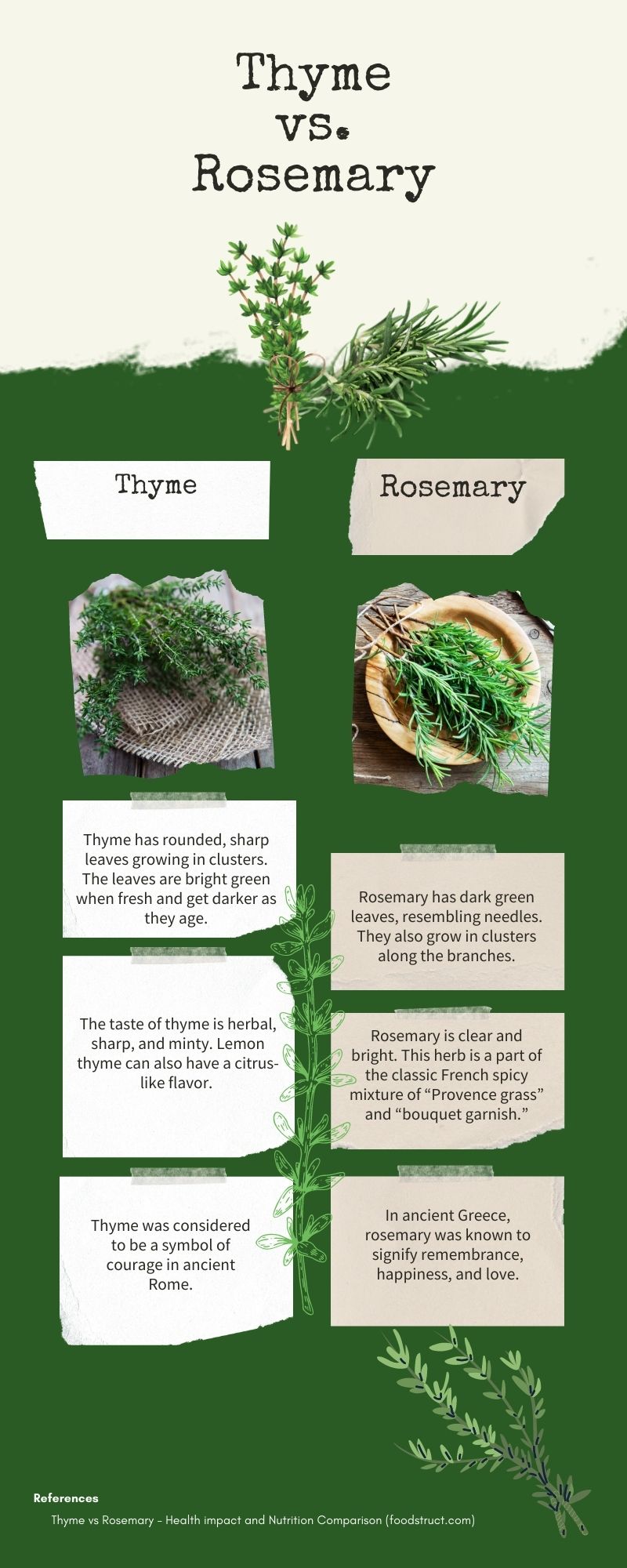
Thyme and rosemary are herbs found in most grocery stores (and on most people’s spice racks). They are also good substitutes for each other.
Both have a strong flavor and a pungent, spicy scent. While we can see the similarities, let’s also look at what makes them different.
Origin
The thyme plant is native to the Mediterranean region and is common in southern Europe and parts of Africa. In ancient times, thyme played a significant role in the customs and beliefs of different cultures.
The rosemary plant is also native to the Mediterranean region and common in the Mediterranean basin, particularly in Spain, France, Italy, and Greece.
Appearance
Thyme has small, delicate leaves that are typically green or grayish-green in color, while rosemary has long, needle-like leaves that are thicker and have a dark green color. Rosemary leaves are also sturdier and woodier than thyme leaves.
Flavor
Thyme has a subtle, earthy flavor with a slightly minty and lemony undertone. Rosemary is a woody herb with a stronger flavor and slightly bitter taste and is used to spice up roasted meats, potatoes, bread, and vegetables.
Applications
Both herbs are versatile and can be used in various dishes but are often used differently. Thyme is used to flavor dishes that require a more herbaceous flavor and works great in chicken, pasta, eggs, beans, stews, tomato-based sauces, and most meat dishes.
Rosemary works best in sweet and savory dishes, such as roasted meats, stews, casseroles, fish, bread, marinades, and dressings, as well as in grilling because it can stand up to the heat.
Shelf life
Fresh thyme and rosemary have a relatively short shelf life and should be used within a few days of purchase, up to 2 weeks.
However, dried thyme and rosemary can last up to a year if stored in an airtight container in a cool, dark place.
Form
Thyme and rosemary are available in various forms, including fresh, dried, powdered, and oil.
Fresh herbs are typically more flavorful (and their green leaves look more beautiful on a plate), but dried herbs are more convenient and have a longer shelf life. You can also add them at the beginning of the cooking process (unlike fresh leaves, which can only be used at the end).
You can also find thyme and rosemary in seed form, which you can use to make your own herb garden.
Comparison Table
| Thyme | Rosemary | |
| Origin | Mediterranean | Mediterranean |
| Appearance | Small, delicate leaves | Long, needle-like leaves |
| Flavor | Subtle, earthy with minty and lemony undertones | Strong, pungent, slightly bitter, and woody |
| Applications | Stews, tomato-based sauces, bread, potatoes, grilled or roasted vegetables, meat dishes | Roasted meats, stews, casseroles, eggs, marinades, dressings |
| Shelf life | Fresh: a few days; dried: up to a year | Fresh: a few days; dried: up to a year |
| Form | Fresh, dried, powdered, oil, seeds | Fresh, dried, powdered, oil, seeds |
Rosemary and thyme, compared to other similar spices
| Rosemary | Woody, pine-like, slightly bitter | Roasted meats, potatoes, soups, stews, marinades, bread, and sauces |
| Thyme | Earthy, minty, slightly sweet | Roasted meats, poultry, fish, vegetables, soups, stews, and sauces |
| Oregano | Pungent, slightly bitter, and earthy | Italian, Greek, and Mexican cuisine, marinades, sauces, and pizzas |
| Tarragon | Anise-like, sweet, and slightly bitter | French cuisine, dressings, sauces, and seafood dishes |
| Anise | Licorice-like, sweet, and warm | Baked goods, cocktails, and savory dishes such as stews and soups |
| Cilantro | Citrusy, slightly bitter, and pungent | Latin American, Caribbean, and Asian cuisine, dressings, and salsa |
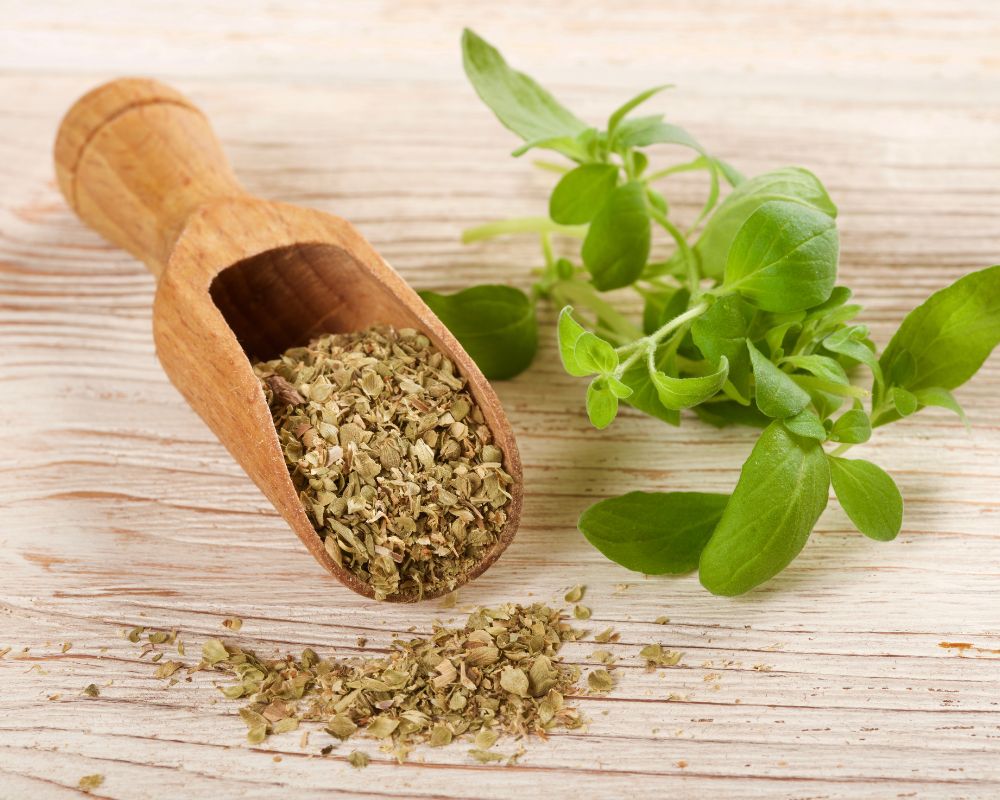
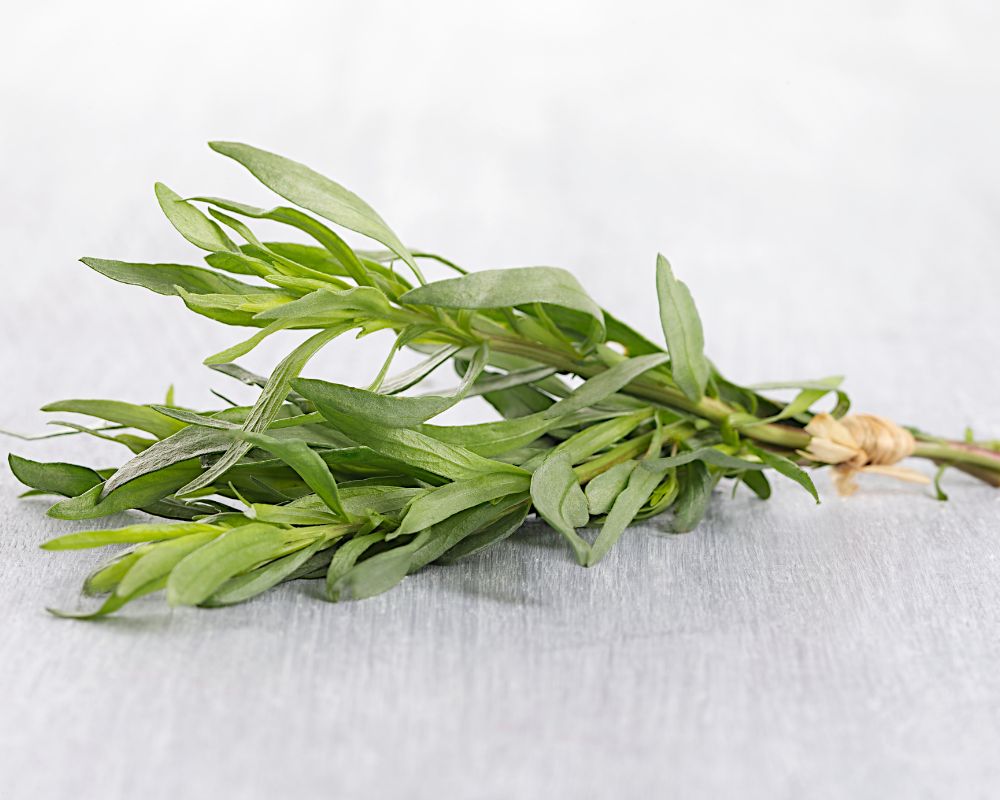

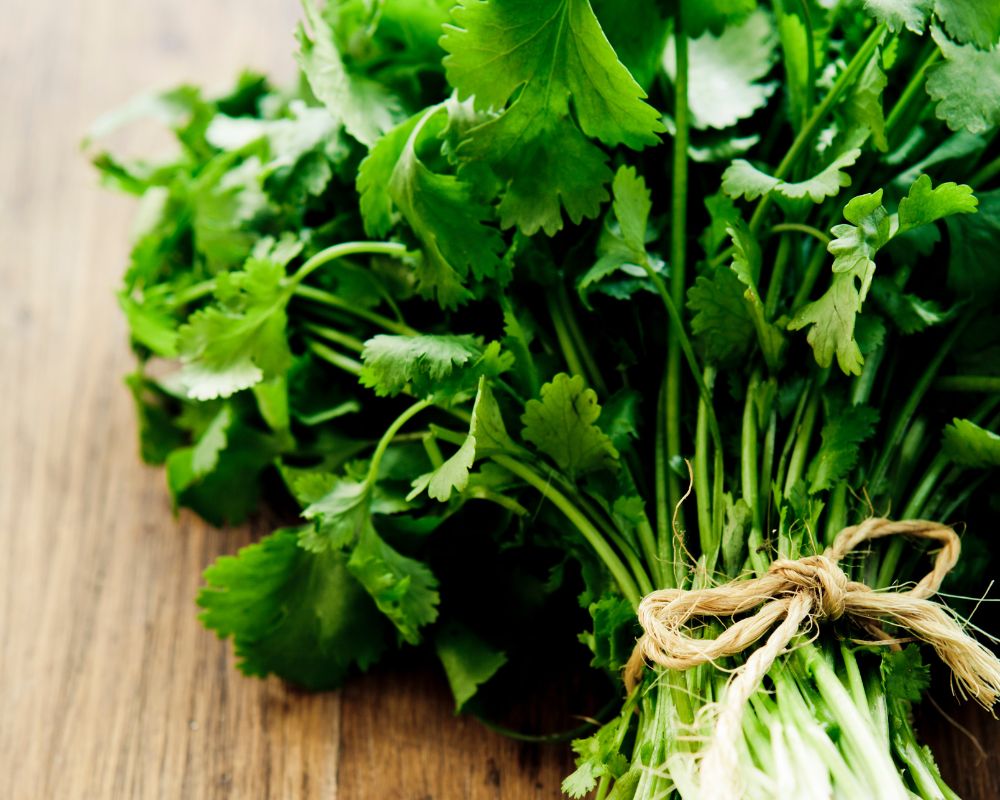
How to use thyme?
Thyme is a versatile herb that can be used fresh or dried. Here are some ideas for using thyme in recipes:
- Add fresh thyme to marinades for chicken, beef, or fish.
- Use dried thyme in soups, stews, and sauces.
- Make thyme butter by mixing softened butter with minced thyme and a pinch of salt. Use it to top grilled or roasted vegetables, baked potatoes, or crusty bread.
- Sprinkle fresh thyme leaves over roasted or sautéed mushrooms.
- Add thyme to homemade salad dressings, like vinaigrettes.
- Use thyme to flavor roasted meats like chicken, lamb, or pork.
How to use rosemary?
Rosemary is a fragrant herb that pairs well with many meats, vegetables, and grains. Here are some ideas for using rosemary in recipes:
- Use fresh rosemary to make a chicken, lamb, or beef marinade.
- Add rosemary to roasted or grilled vegetables, such as potatoes, carrots, or zucchini.
- Use dried rosemary to flavor tomato-based sauces, like marinara or bolognese.
- Make a rosemary-infused oil by heating olive oil with fresh rosemary sprigs. Use it to dress salads or drizzle over grilled meats or vegetables.
- Sprinkle fresh rosemary leaves over roasted or grilled mushrooms.
- Use rosemary to flavor roasted meats, like beef or pork.
Can you use thyme and rosemary together?
You definitely can use these two herbs together. A lot of recipes require the use of both.
Both thyme and rosemary have a woody, earthy taste with notes of pine and citrus, and they can add depth and complexity to a wide range of dishes. Thyme often adds a savory, herby flavor to roasted meats, stews, and soups.
Rosemary is also commonly used in dishes with meat, but it has a more pronounced pine-like flavor and is particularly well-suited for roasted or grilled meats and vegetables.
When using thyme and rosemary together, you can experiment with different ratios depending on the dish and your taste. A good starting point is to use roughly equal amounts of each herb or slightly more thyme than rosemary.
Fresh thyme has a milder, more subtle flavor than dried thyme, which has a more concentrated and potent flavor. Fresh rosemary also has a milder flavor than dried rosemary, which can be intense and aromatic.
When using fresh herbs, it’s best to add them towards the end of the cooking process as a garnish to preserve their delicate flavor. On the other hand, dried herbs can be added earlier in the cooking process to allow their flavors to develop and infuse into the dish.
Examples of dishes in which you can use both thyme and rosemary:
- Roasted chicken
- Grilled vegetables
- Soups and stews
- Roasted potatoes
- Meat marinade
- Bread
- Herb-infused oil
Which is better – rosemary or thyme?
Rosemary and thyme are versatile herbs that can add delicious flavor to various dishes. Which herb is better depends on the recipe and personal preference.
Rosemary has a piney, woody flavor with hints of citrus and mint, and it’s present in Mediterranean cuisine, especially roasted meats, potatoes, and vegetables. Rosemary is also a great addition to marinades, salad dressings, and bread dough.
Thyme has a slightly sweet and earthy flavor with hints of lemon and mint. It is common in Italian cuisine, especially in soups, stews, and sauces. Thyme also pairs well with poultry, fish, and vegetables.
When choosing rosemary or thyme for a recipe, consider the flavor profile of other ingredients and what kind of taste you’re trying to achieve. You could also combine the two herbs to add complexity to the dish.
Which is better in a chicken pot pie, thyme or rosemary?
Both thyme and rosemary can work for a chicken pot pie, but thyme is more commonly used as it pairs well with the chicken and other vegetables typically included in the dish.
Which is better on steak, thyme or rosemary?
Thyme has a subtle earthy and slightly minty flavor that pairs well with beef, while rosemary has a strong and distinctive pine-like flavor that complements beef. Consider using a blend of both herbs to get the benefits of both flavors.
Should I use thyme or rosemary for potatoes?
Both thyme and rosemary can add flavor, but rosemary is more commonly used for roasted potatoes, while thyme works well for mashed or boiled potatoes. Ultimately, the choice between thyme and rosemary will depend on personal preference and the overall flavor profile of the dish.
Can I substitute thyme for rosemary?
Thyme and rosemary share some similarities in flavor and aroma, so they can be interchangeable in most recipes. In recipes that call for dried rosemary, you can use an equal amount of dried thyme instead – and vice versa.

